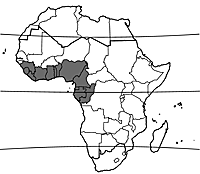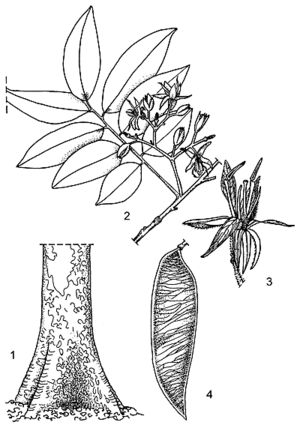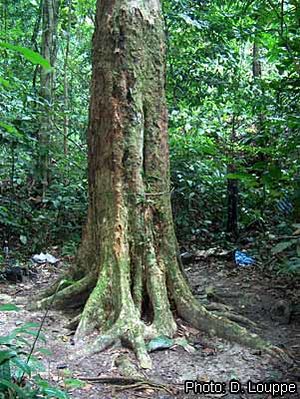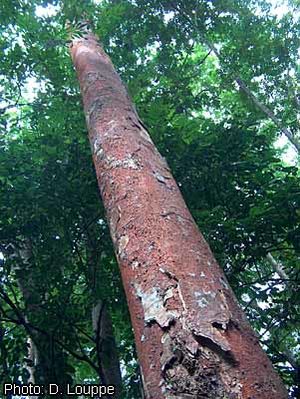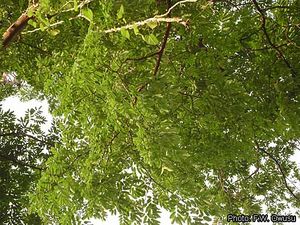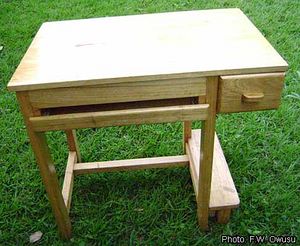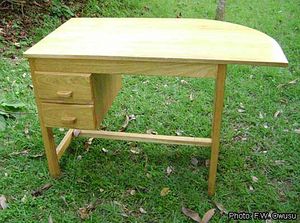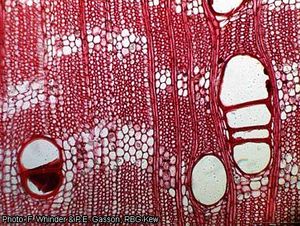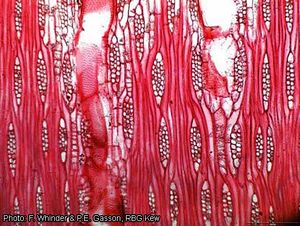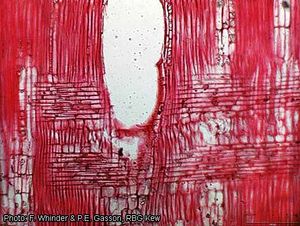Distemonanthus benthamianus (PROTA)
Introduction |
| General importance | |
| Geographic coverage Africa | |
| Geographic coverage World | |
| Dye / tannin | |
| Medicinal | |
| Timber | |
| Fuel | |
Distemonanthus benthamianus Baill.
- Protologue: Hist. pl. 2: 135 (1870).
- Family: Caesalpiniaceae (Leguminosae - Caesalpinioideae).
- Chromosome number: 2n = 24
Vernacular names
- African satinwood, yellow satinwood (En).
- Movingui (Fr).
Origin and geographic distribution
Distemonanthus benthamianus occurs from Guinea and Sierra Leone eastward to Cameroon, and southward to Gabon and southern Congo.
Uses
The wood, traded as ‘movingui’, ‘African satinwood’ and ‘yellow satinwood’, is used for a variety of purposes such as heavy construction including hydraulic works, heavy flooring, carpentry, mine props, ship building, vehicle bodies, railway sleepers, furniture for interior as well as exterior use, cabinet making, sporting goods, musical instruments, crates, boxes, agricultural implements, tool handles, vats for chemical products, shingles, carvings, turnery, veneer and plywood. It is also used as firewood and for charcoal production.
The bark is used in traditional medicine. Pounded bark is applied to skin complaints including furuncles and abscesses, used as a sniff against epilepsy, taken to treat palpitation and used as an enema to treat hepatitis. Bark decoctions are used in a bath or as a vapour bath to treat bronchitis, rheumatism, and fever including malaria. In Nigeria twigs are used as chewing sticks. The yellow dye from the roots has been used for body decoration. The tree is used in many local ritual ceremonies.
Production and international trade
In 1983 Côte d’Ivoire exported 38,000 m³ of ‘movingui’ logs, but only 180 m³ in 1996. In 1999 ‘movingui’ timber ranked 10eth on the list of most important export timbers of Gabon, with 28,000 m³ of logs exported. In 2000 Gabon exported 36,000 m³ of logs, but the amount decreased to 12,000 m³ in 2009. In 2004 Congo exported 4000 m³ of sawn Distemonanthus benthamianus wood at an average price of US$ 134/m³, and 1200 m³ in 2009. In 2005 export of sawn wood from Cameroon was 14,000 m³ at an average price of US$ 340/m³, and in 2006 12,000 m³ at an average price of 514/m³. In 2009 Cameroon exported 5000 m³ of logs and 5500 m³ of sawn wood. The bark is sold in local markets in Gabon for medicinal purposes. In Ghana considerable volumes of Distemonanthus benthamianus wood are exported, mainly as sliced veneer and mouldings.
Properties
The heartwood is yellow to golden yellow, darkening to orange-brown upon exposure, sometimes with pinkish brown streaks, and distinctly demarcated from the whitish to greyish or straw-coloured, up to 4 cm wide sapwood. The grain is wavy to interlocked, texture medium to fine and even. The wood is slightly lustrous and quite decorative. Radial surfaces show a ribbon figure. The wood is not recommended for the manufacture of laundry and kitchen equipment because it often contains a yellow, water-soluble extractive.
The wood is medium-weight to fairly heavy, with a density of 570–860 kg/m³ at 12% moisture content, and fairly hard. It air dries well but quite slowly, with little degrade, but with a slight tendency of developing end checks and surface checks. The rates of shrinkage are low to medium, from green to oven dry 3.0–4.4% radial and 5.0–7.2% tangential. Once dry, the wood is moderately stable to stable in service.
At 12% moisture content, the modulus of rupture is (103–)140–207 N/mm², modulus of elasticity 8400–12,950(–14,740) N/mm², compression parallel to grain 45–69(–85) N/mm², shear 12.5–14.5 N/mm², cleavage 12.5–21.5 N/mm, Janka side hardness 5470–6290 N, Janka end hardness 7330 N and Chalais-Meudon side hardness (2.9–)4.3–7.7.
The sawing and working characteristics are variable depending on the amounts of silica and exudate in the wood. Fresh wood is quite easy to saw, but dry wood more difficult and may cause over-heating of saw blades. When the silica content is high, stellite-tipped saw teeth and tungsten-carbide cutting edges are recommended; the wood may contain up to 1.3% silica. Quarter-sawn surfaces may show picking up of grain in moulding and planing operations, and a reduced cutting angle of 20° is recommended. The wood can take a nice finish and polishes well when a filler is used. The nailing and screwing characteristics are variable; splitting may be a problem and pre-boring is advised, but the wood holds nails and screws well. It glues satisfactorily. The use of a filler is recommended before painting. The steam bending properties are good. The wood can be sliced for the production of good-quality veneer. It can also be peeled, but this is rarely done because the veneer is not nicely figured. Steaming of the wood for 48 hours before slicing or peeling is needed to obtain veneer with a good flexibility. Tests showed that the wood is well suited for the production of glued laminated elements.
The heartwood is moderately durable, being moderately resistant to fungal and termite attacks, and quite resistant to dry-wood borer attack. In tests in Turkey, the wood showed good durability against marine borers, but this may depend on the silica content. The heartwood is resistant to impregnation with preservatives. The saw dust may cause dermatitis in wood workers.
The wood contains 37% cellulose, 27% lignin, 12.5% pentosan, 2.7% ash and (0.2–)0.4–0.8(–1.3)% silica. The solubility is 13.0% in alcohol-benzene, 1.3% in hot water and 16.1% in a 1% NaOH solution.
Aqueous and chloroform extracts of the bark showed in-vitro antibacterial activity against several bacteria implicated in oral and dental infections. The extract contained tannins, steroids, saponins and alkaloids.
Adulterations and substitutes
In Ghana the wood of Distemonanthus benthamianus is considered a substitute for the woods of Sterculia oblonga Mast., Nauclea diderrichii (De Wild. & T.Durand) Merr. and Piptadeniastrum africanum (Hook.f.) Brenan. The wood properties are comparable to European beech and oak.
Description
- Deciduous medium-sized to large tree up to 40 m tall; bole branchless for up to 25 m, usually straight and cylindrical, up to 130 cm in diameter, often with short, rounded buttresses; bark surface smooth, orange to red, becoming pale green to yellowish, peeling off in large, irregular patches, inner bark thin, fibrous, cream-coloured to orange or pink-brown, sticky; crown umbrella-shaped, fairly open; twigs short-hairy but soon glabrous, purplish.
- Leaves alternate, imparipinnately compound with (4–)7–11(–13) leaflets; stipules narrowly oblong, c. 7 mm long, caducous; petiole (1–)2–4 cm long, rachis 6–18 cm long; petiolules 3–6 mm long; leaflets alternate, ovate to elliptical, (3.5–)5–10 cm × (1.5–)2.5–5 cm, rounded at base, usually short-acuminate at apex, thick-papery, slightly hairy below, pinnately veined with 8–13 pairs of lateral veins. Inflorescence an axillary panicle-like cyme up to 10(–30) cm long, short-hairy.
- Flowers bisexual, slightly zygomorphic, showy; pedicel slender, up to 1 cm long, hairy; sepals 5, free, lanceolate, c. 1 cm long, 2 broader than other 3, recurved, reddish brown; petals 3, free, narrowly elliptical, slightly longer than sepals, 1 slightly broader than other 2, white; stamens 2, up to 1.5 cm long, rudimentary stamens 3; ovary superior, c. 0.5 cm long, brown hairy, 1-celled, style c. 0.5 cm long, glabrous.
- Fruit a flattened elliptical pod 7–13 cm × 2.5–3.5 cm, papery, reticulately veined, indehiscent, 2–5-seeded.
- Seeds flattened elliptical, c. 1 cm × 0.5 cm, glossy brown.
- Seedling with epigeal germination; hypocotyl 4–5 cm long, quadrangular, epicotyl c. 0.5 cm long; cotyledons leafy, obovate, up to 2 cm long; first 2 leaves opposite, simple.
Other botanical information
Distemonanthus comprises a single species and seems to have a rather isolated position.
Anatomy
Wood-anatomical description (IAWA hardwood codes):
- Growth rings: 2: growth ring boundaries indistinct or absent.
- Vessels: 5: wood diffuse-porous; 13: simple perforation plates; 22: intervessel pits alternate; 23: shape of alternate pits polygonal; 25: intervessel pits small (4–7 μm); 26: intervessel pits medium (7–10 μm); (27: intervessel pits large (≥ 10 μm)); 30: vessel-ray pits with distinct borders; similar to intervessel pits in size and shape throughout the ray cell; 42: mean tangential diameter of vessel lumina 100–200 μm; 47: 5–20 vessels per square millimetre; 58: gums and other deposits in heartwood vessels.
- Tracheids and fibres: 61: fibres with simple to minutely bordered pits; 66: non-septate fibres present; 69: fibres thin- to thick-walled.
- Axial parenchyma: 80: axial parenchyma aliform; 82: axial parenchyma winged-aliform; 83: axial parenchyma confluent; (85: axial parenchyma bands more than three cells wide); (89: axial parenchyma in marginal or in seemingly marginal bands); 92: four (3–4) cells per parenchyma strand; 93: eight (5–8) cells per parenchyma strand.
- Rays: 97: ray width 1–3 cells; 106: body ray cells procumbent with one row of upright and/or square marginal cells; 107: body ray cells procumbent with mostly 2–4 rows of upright and/or square marginal cells; 113: disjunctive ray parenchyma cell walls present; 115: 4–12 rays per mm.
- Storied structure: 118: all rays storied; 120: axial parenchyma and/or vessel elements storied.
- Mineral inclusions: 136: prismatic crystals present; 140: prismatic crystals in chambered upright and/or square ray cells; 142: prismatic crystals in chambered axial parenchyma cells; 159: silica bodies present; 160: silica bodies in ray cells; 161: silica bodies in axial parenchyma cells.
Growth and development
Growth of seedlings in the nursery is slow; they reach 10–25 cm in height after 5 months. In Guinea they were on average 100 cm tall when planted in moderate shade and 160 cm in full sun 2 years after planting. The survival rate of seedlings planted at 625 plants/ha in Gabon was 100% after one year when planted in the open as well as in opened-up forest, and after 6 years it was 80% and 60%, respectively. After 6 years the mean height was 11 m and the mean bole diameter 10 cm when planted in the open and 6.5 m and 4.5 cm, respectively, when planted in the forest. After 11 years the mean height was 16.5 m and the mean bole diameter 11.5 cm in the open and 11 m and 6 cm, respectively, in the shade. The mean annual diameter growth of the bole in natural forest is estimated at 3–4 mm. In an arboretum in Cameroon, the mean annual diameter growth of planted trees without thinning was 5 mm, but it varied widely from 1 mm to 11 mm.
Trees may start to fruit when the bole is only 20 cm in diameter, but only trees with a bole diameter of more than 40 cm fruit regularly. The tree is leafless for a short period. New foliage is coppery red and followed by the quite conspicuous flowers. In Liberia flowering is in January–February and in Ghana usually in February–July, and fruits ripen about 6 months later. Fruiting is reported to be sparse and not annually. In Central Africa fruiting usually occurs at the end of the short dry season. The fruits are dispersed by wind up to 50 m from the mother tree. Monkeys and parrots feed on the seeds. The roots are associated with mycorrhizae.
Ecology
Distemonanthus benthamianus occurs in evergreen and moister types of semi-deciduous forest, also in disturbed forest but not in swampy locations. In West Africa it is more common in moist semi-deciduous forest than in evergreen forest. It prefers regions with a mean annual rainfall of 2000 mm. It does not appear to have any soil preference.
Propagation and planting
Distemonanthus benthamianus is classified as a non-pioneer light demander, and natural regeneration is limited in mature forest; few saplings are found in forest with a closed canopy. However, seedlings and saplings can be found in the understorey of the forest and tolerate shade. Regeneration in disturbed forest may occur, but is neither abundant. However, in Gabon seedlings have been reported to be locally abundant in secondary and planted forests. To promote regeneration, it was proposed to open the forest canopy just before the trees fruit.
The seeds are difficult to collect, mainly because fruiting is irregular. There are about 2500 seeds per kg. The seeds take 2–6.5 weeks, sometimes to 5 months, to germinate after sowing and the germination rate is generally moderate, in Guinea 13–26%, although it has also been reported to be 90%. Soaking the seeds in water for 24 hours or in sulphuric acid for 30 minutes promotes germination. The fastest growing seedlings are about 40 cm tall and ready for planting when 4–5 months old, but generally they need to stay in the nursery for at least one year. Wildlings are occasionally collected for planting. A spacing of 3 m × 3 m is recommended for planting in the field. Distemonanthus benthamianus is sometimes planted in mixtures with other species having similar growth rates, such as Nauclea diderrichii (De Wild. & T.Durand) Merr., Afzelia bella Harms, Bussea occidentalis Hutch. and Paramacrolobium coeruleum (Taub.) J.Léonard.
Management
Distemonanthus benthamianus usually occurs scattered in the forest, occasionally in small groups. In Ghana the average wood volume has been estimated at 0.6 m³/ha and the total exploitable volume of trees with a bole diameter of more than 70 cm at 250,000 m³; the annual allowable cut volume is 6300 m³. In Cameroon the average density is up to 0.3 trees with a bole diameter of more than 60 cm per ha, with a mean wood volume of up to 2 m³/ha. In Gabon the average wood volume has been estimated at 0.3 m³/ha.
Harvesting
Some caution is needed at felling because the bole may have internal stresses and wind shakes. The minimum bole diameter allowed for harvesting is 60 cm in Côte d’Ivoire and Cameroon and 70 cm in Ghana and Gabon.
Yield
One large tree may yield 8–15 m³ of wood.
Handling after harvest
Logs are fairly durable and can be left in the forest for some time after felling without serious deterioration. However, the sapwood is susceptible to fungal and borer attacks, and deep splits may develop in the logs if they are left too long. Logs sink in water and cannot be transported by river.
Genetic resources
Distemonanthus benthamianus is widespread, but usually occurs scattered in the forest in low densities. In general, it does not seem to suffer from genetic erosion at present, also because it is commonly found in secondary forest and is exploited on a moderate level, but locally it may be vulnerable, e.g. in southern Cameroon where it is considered to be susceptible to genetic erosion due to logging activities. Monitoring of the populations is recommended.
An analysis of the spatial genetic structure of Distemonanthus benthamianus in Cameroon and Gabon showed the existence of 3 clearly differentiated gene pools, probably as a result of forest fragmentation in cool and dry periods in the past when the species survived in some relict populations, from which it expanded again when the climate became warmer and wetter.
Prospects
There is an export market for the durable and multipurpose timber of Distemonanthus benthamianus. In Ghana it has been suggested as a substitute of similar timbers which have become rare due to over-exploitation, whereas in several Central African countries it already has established a position amongst the more important export timbers. Natural regeneration is sparse, and this may hamper sustainable exploitation from the forest. Research is needed on appropriate methods of silvicultural management.
Major references
- Bolza, E. & Keating, W.G., 1972. African timbers: the properties, uses and characteristics of 700 species. Division of Building Research, CSIRO, Melbourne, Australia. 710 pp.
- Burkill, H.M., 1995. The useful plants of West Tropical Africa. 2nd Edition. Volume 3, Families J–L. Royal Botanic Gardens, Kew, Richmond, United Kingdom. 857 pp.
- CIRAD Forestry Department, 2009. Movingui. [Internet] Tropix 6.0. http://tropix.cirad.fr/ africa/ movingui.pdf. March 2012.
- CTFT (Centre Technique Forestier Tropical), 1947. Movingui. Fiche botanique, forestière, industrielle et commerciale. Bois et Forêts des Tropiques 2: 59–62.
- Debout, G.D.G., Doucet, J.-L. & Hardy, O.J., 2011. Population history and gene dispersal inferred from spatial genetic structure of a Central African timber tree, Distemonanthus benthamianus (Caesalpinioideae). Heredity 106(1): 88–99.
- Guiscafre, J. & Sales, C., 1975. Etude de l’aptitude du movingui (Distemonanthus benthamianus) à l’utilisation en lamellé-collé. Bois et Forêts des Tropiques 161: 35–40.
- Koumba Zaou, P., Mapaga, D., Nze Nguema, S. & Deleporte, P., 1998. Croissance de 13 essences de bois d’œuvre plantées en forêt Gabonaise. Bois et Forêts des Tropiques 256(2): 21–32.
- Oteng-Amoako, A.A. (Editor), 2006. 100 tropical African timber trees from Ghana: tree description and wood identification with notes on distribution, ecology, silviculture, ethnobotany and wood uses. 304 pp.
- Takahashi, A., 1978. Compilation of data on the mechanical properties of foreign woods (part 3) Africa. Shimane University, Matsue, Japan. 248 pp.
- Voorhoeve, A.G., 1979. Liberian high forest trees. A systematic botanical study of the 75 most important or frequent high forest trees, with reference to numerous related species. Agricultural Research Reports 652, 2nd Impression. Centre for Agricultural Publishing and Documentation, Wageningen, Netherlands. 416 pp.
Other references
- Adjanohoun, E.J., Ahyi, A.M.R., Aké Assi, L., Baniakina, J., Chibon, P., Cusset, G., Doulou, V., Enzanza, A., Eymé, J., Goudoté, E., Keita, A., Mbemba, C., Mollet, J., Moutsamboté, J.-M., Mpati, J. & Sita, P. (Editors), 1988. Médecine traditionnelle et pharmacopée - Contribution aux études ethnobotaniques et floristiques en République Populaire du Congo. Agence de Coopération Culturelle et Technique, Paris, France. 606 pp.
- Aiyegoro, O.A., Akinpelu, D.A., Afolayan, A.J. & Okoh, A.I., 2008. Antibacterial activities of crude stem bark extracts of Distemonanthus benthamianus Baill. Journal of Biological Sciences 8(2): 356–361.
- ATIBT (Association Technique Internationale des Bois Tropicaux), 1986. Tropical timber atlas: Part 1 – Africa. ATIBT, Paris, France. 208 pp.
- Aubréville, A., 1968. Légumineuses - Caesalpinioidées (Leguminosae - Caesalpinioideae). Flore du Gabon. Volume 15. Muséum National d’Histoire Naturelle, Paris, France. 362 pp.
- Aubréville, A., 1970. Légumineuses - Césalpinioidées (Leguminosae - Caesalpinioideae). Flore du Cameroun. Volume 9. Muséum National d’Histoire Naturelle, Paris, France. 339 pp.
- Christy, P., Jaffré, R., Ntougou, O. & Wilks, C., 2003. La forêt et la filière bois au Gabon. Projet Aménagement Forestier et Environnement, Libreville, Gabon. 389 pp.
- de la Mensbruge, G., 1966. La germination et les plantules des essences arborées de la forêt dense humide de la Côte d’Ivoire. Centre Technique Forestier Tropical, Nogent-sur-Marne, France. 389 pp.
- de Saint-Aubin, G., 1963. La forêt du Gabon. Publication No 21 du Centre Technique Forestier Tropical, Nogent-sur-Marne, France. 208 pp.
- Gassita, J.N., Nze Ekekang, L., De Vecchy, H., Louis, A.M., Koudogbo, B. & Ekomié, R. (Editors), 1982. Les plantes médicinales du Gabon. CENAREST, IPHAMETRA, mission ethnobotanique de l’ACCT au Gabon, 10–31 juillet 1982. 26 pp.
- Hawthorne, W.D., 1995. Ecological profiles of Ghanaian forest trees. Tropical Forestry Papers 29. Oxford Forestry Institute, Department of Plant Sciences, University of Oxford, United Kingdom. 345 pp.
- Hawthorne, W. & Jongkind, C., 2006. Woody plants of western African forests: a guide to the forest trees, shrubs and lianes from Senegal to Ghana. Kew Publishing, Royal Botanic Gardens, Kew, United Kingdom. 1023 pp.
- Irvine, F.R., 1961. Woody plants of Ghana, with special reference to their uses. Oxford University Press, London, United Kingdom. 868 pp.
- Keay, R.W.J., 1989. Trees of Nigeria. A revised version of Nigerian trees (1960, 1964) by Keay, R.W.J., Onochie, C.F.A. & Stanfield, D.P. Clarendon Press, Oxford, United Kingdom. 476 pp.
- Neuwinger, H.D., 2000. African traditional medicine: a dictionary of plant use and applications. Medpharm Scientific, Stuttgart, Germany. 589 pp.
- Ngavoura, P., 1990. Fiabilité de la médecine traditionnelle dans le monde moderne - “Contribution du forestier”. Mémoire de fin de cycle, Ecole nationale des eaux et forêts (ENEF), Cap-Estérias, Gabon. 115 pp.
- Raponda-Walker, A. & Sillans, R., 1961. Les plantes utiles du Gabon. Paul Lechevalier, Paris, France. 614 pp.
- Siepel, A., Poorter, L. & Hawthorne, W.D., 2004. Ecological profiles of large timber species. In: Poorter, L., Bongers, F., Kouamé, F.N. & Hawthorne, W.D. (Editors). Biodiversity of West African forests. An ecological atlas of woody plant species. CABI Publishing, CAB International, Wallingford, United Kingdom. pp. 391–445.
- Tailfer, Y., 1989. La forêt dense d’Afrique centrale. Identification pratique des principaux arbres. Tome 2. CTA, Wageningen, Pays-Bas. pp. 465–1271.
- Vivien, J. & Faure, J.J., 1985. Arbres des forêts denses d’Afrique Centrale. Agence de Coopération Culturelle et Technique, Paris, France. 565 pp.
- White, L. & Abernethy, K., 1997. A guide to the vegetation of the Lopé Reserve, Gabon. 2nd edition. Wildlife Conservation Society, New York, United States. 224 pp.
Sources of illustration
- Voorhoeve, A.G., 1979. Liberian high forest trees. A systematic botanical study of the 75 most important or frequent high forest trees, with reference to numerous related species. Agricultural Research Reports 652, 2nd Impression. Centre for Agricultural Publishing and Documentation, Wageningen, Netherlands. 416 pp.
- Wilks, C. & Issembé, Y., 2000. Les arbres de la Guinée Equatoriale: Guide pratique d’identification: région continentale. Projet CUREF, Bata, Guinée Equatoriale. 546 pp.
Author(s)
- F.W. Owusu, Forestry Research Institute of Ghana (FORIG), University P.O. Box 63, KNUST, Kumasi, Ghana
- D. Louppe, CIRAD, Département Environnements et Sociétés, Cirad es-dir, Campus international de Baillarguet, TA C 105 / D (Bât. C, Bur. 113), 34398 Montpellier Cédex 5, France
Correct citation of this article
Owusu, F.W. & Louppe, D., 2012. Distemonanthus benthamianus Baill. [Internet] Record from PROTA4U. Lemmens, R.H.M.J., Louppe, D. & Oteng-Amoako, A.A. (Editors). PROTA (Plant Resources of Tropical Africa / Ressources végétales de l’Afrique tropicale), Wageningen, Netherlands.
Accessed 31 May 2025.
- See the Prota4U database.

